- Quick Read
- Deep Read ( 15 Min. )

Why is Christian Science in our name?
Our name is about honesty. The Monitor is owned by The Christian Science Church, and we’ve always been transparent about that.
The Church publishes the Monitor because it sees good journalism as vital to progress in the world. Since 1908, we’ve aimed “to injure no man, but to bless all mankind,” as our founder, Mary Baker Eddy, put it.
Here, you’ll find award-winning journalism not driven by commercial influences – a news organization that takes seriously its mission to uplift the world by seeking solutions and finding reasons for credible hope.
Explore values journalism About usIn Today’s Issue
Monitor Daily Podcast
- Follow us:
- Apple Podcasts
- Spotify
- RSS Feed
- Download
TODAY’S INTRO
How the Monitor would cover a second Trump presidency
 Mark Sappenfield
Mark Sappenfield
In many quarters of the media, the prospect of a second Donald Trump presidency has set alarm bells ringing. Today, the Monitor’s Peter Grier and Sophie Hills take stock.
But what is the Monitor’s viewpoint? You can read my full column here.
The essentials boil down to two key points: First, the Monitor has long reported clearly and factually on anti-democratic movements and politicians. We won’t stop now, and we won’t be afraid to point that lens at the United States.
Yet in doing this work, the Monitor should also never give in to fear, personal opinion, or speculation. What we can do is calmly watch, challenge our own biases, and report honestly. Which is what we have been doing for 115 years.
Share this article
Link copied.

Help fund Monitor journalism for $11/ month
Already a subscriber? Login

Monitor journalism changes lives because we open that too-small box that most people think they live in. We believe news can and should expand a sense of identity and possibility beyond narrow conventional expectations.
Our work isn't possible without your support.
A deeper look
Talk of a Trump ‘dictatorship’: What’s behind the fears
The question of whether a second Trump term would result in the collapse of U.S. democracy has gripped pundits and political insiders. What’s bluster and what’s believable? History offers context.
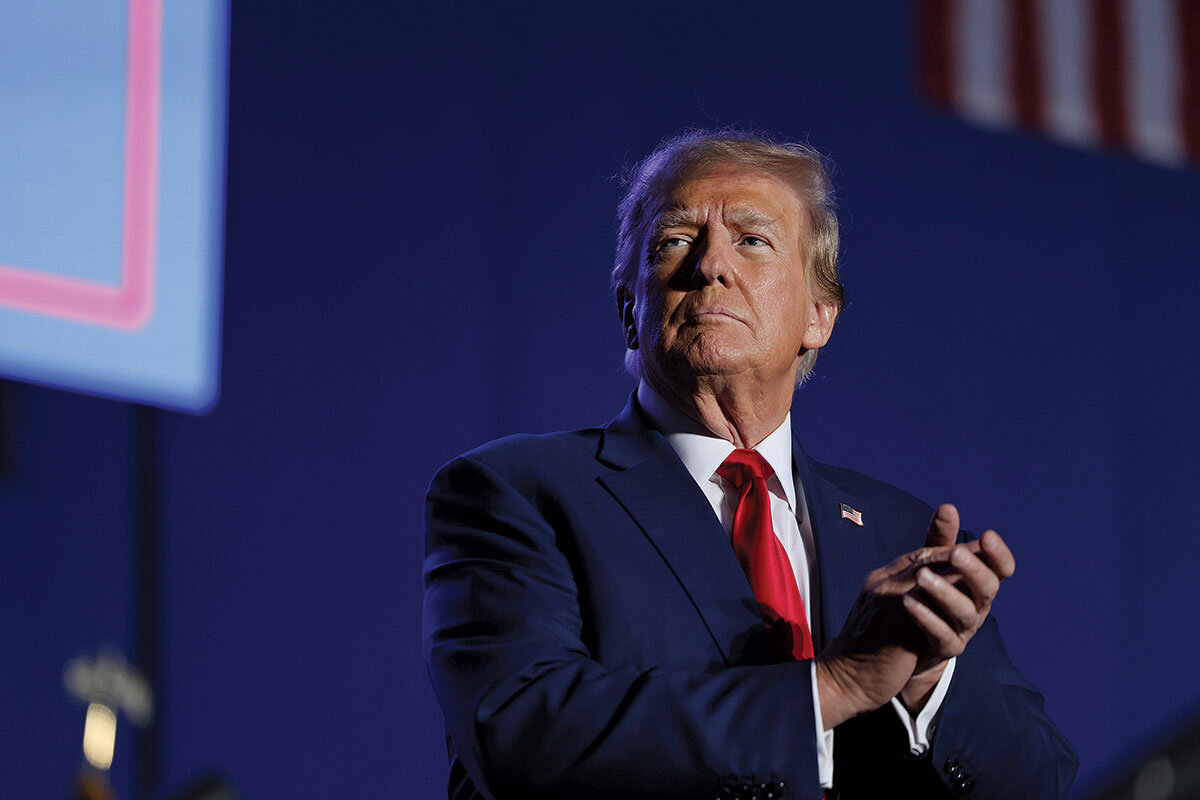
-
Sophie Hills Staff writer
With the 2024 election cycle about to begin in Iowa, Democrats, anti-Trump Republicans, and many in the media are once again sounding alarms about former President Donald Trump – and the impact his potential reelection could have on American democracy.
President Joe Biden will give a speech tomorrow in Valley Forge, Pennsylvania, marking the third anniversary of the Jan. 6 riot at the U.S. Capitol and warning democracy itself is on the ballot. Neoconservative Robert Kagan has argued in The Washington Post that a Trump “dictatorship” is “increasingly inevitable.” The Atlantic has a special issue devoted to its dire vision of an authoritarian Trump White House.
Mr. Trump’s defenders say his critics have “Trump derangement syndrome” and are overreacting to his political antics. And certainly, many other U.S. presidents have been called dictatorial and worse.
Yet the Trump team has floated a number of proposals for a second term that experts on democracy deem alarming – such as weaponizing the Justice Department, expanding the use of U.S. troops at home, and filling the federal bureaucracy with loyalists.
“It’s important not to overstate the threat that Trump poses to democracy,” says Stephen Vladeck, a professor at the University of Texas at Austin School of Law, “but it’s also important not to understate it.”
Talk of a Trump ‘dictatorship’: What’s behind the fears
As he interviewed former President Donald Trump in front of a town hall audience in early December, Fox News host Sean Hannity tossed out what seemed an obvious softball. Could Mr. Trump just reassure America, once and for all, that he “would never abuse power as retribution against anybody?”
Mr. Trump, however, had other plans.
“Except for Day 1,” he said, straight-faced and staring at Mr. Hannity. He paused for the briefest of beats, and then turned to the audience with a glimmer of a smile.
“He’s going crazy,” said the former president, pointing at Mr. Hannity as the audience chuckled.
“He says, ‘You’re not going to be a dictator, are you?’” Mr. Trump continued. “I say no, no, except for Day 1. We’re closing the border, and we’re drilling, drilling, drilling. After that – I’m not a dictator, OK.”
As the Iowa caucuses and the official beginning of the 2024 election cycle arrive, the question of whether a second Trump term would result in the collapse of American democracy as we know it has gripped much of official Washington and U.S. pundits and political insiders.
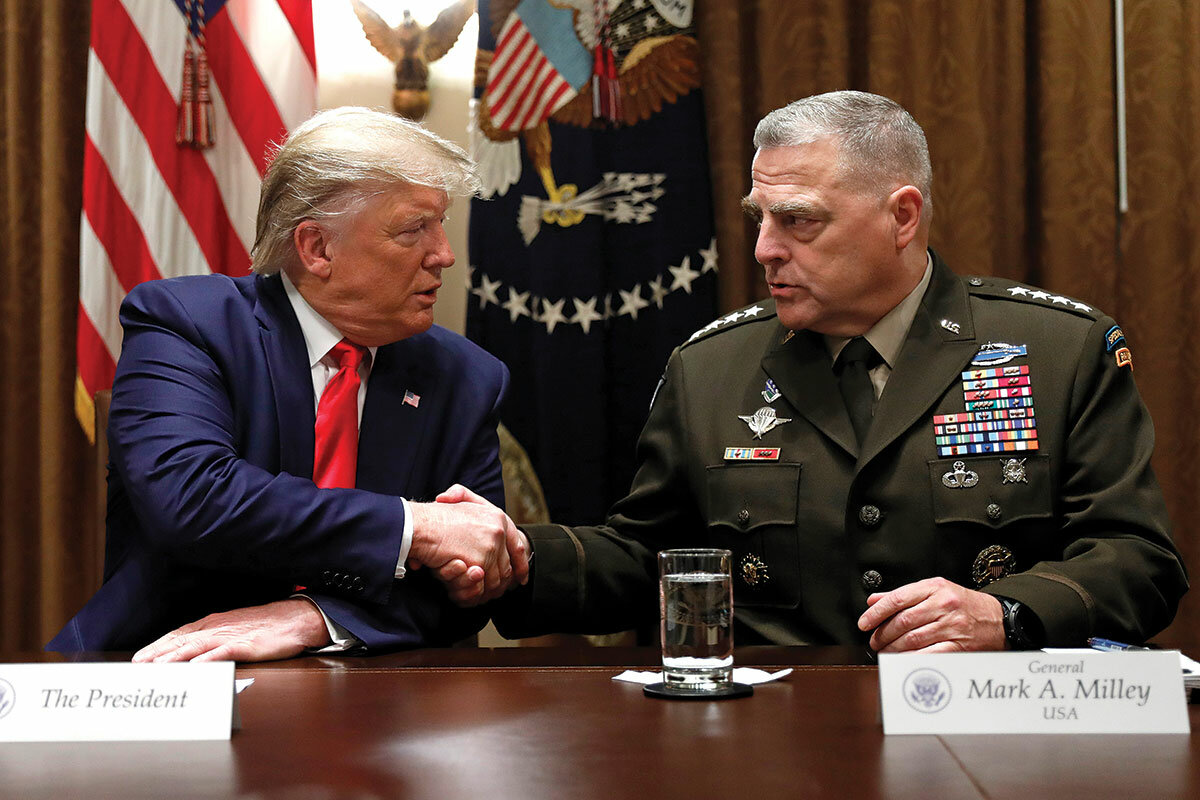
Mr. Trump’s own words have fed this narrative. Among other things, he’s dehumanized political opponents as “vermin” who need to be exterminated, proposed that shoplifters be shot, said immigrants are “poisoning the blood of our country,” and suggested that former Chairman of the Joint Chiefs of Staff Mark Milley should be executed after a trial for treason.
His critics say those words should be considered against the background of past actions. They point to what the former president actually did in the wake of the 2020 election, when he falsely insisted the election had been stolen despite lack of evidence and numerous court rulings against him. He pushed state officials to overturn their results, tried to shut down the Electoral College vote count in Congress, and considered seizing voting machines with the U.S. military.
Former GOP Rep. Liz Cheney calls Mr. Trump the “most dangerous man ever to inhabit the Oval Office” in her new memoir. Noted neoconservative scholar Robert Kagan wrote a lengthy piece in The Washington Post arguing a Trump dictatorship is “increasingly inevitable.” The Atlantic has published a special issue devoted almost entirely to its dire vision of a second Trump White House.
Tomorrow, President Joe Biden will give a speech in Valley Forge, Pennsylvania, marking the third anniversary of the Jan. 6 riot at the U.S. Capitol and warning democracy itself is on the ballot.
Meanwhile, Mr. Trump has reacted as he often has in similar situations, using the uproar to create a political spectacle, with himself as the attention-grabbing center.
As in his answer to Mr. Hannity, he has at times dealt with the subject teasingly, dangling the prospect of authoritarian moves yet then backing off, as if it were all a joke.
At other times, particularly at his political rallies or on Truth Social posts, he can be much darker, as when he called for the “termination” of parts of the Constitution over his false claim that the 2020 election was stolen.
So has America’s government “by the people” truly reached a turning point? Mr. Trump’s defenders often scoff that his critics have “Trump derangement syndrome” and overreact to his political antics. Many presidents, up to and including Mr. Trump’s predecessors George W. Bush and Barack Obama, have been called dictatorial, anti-democratic, and worse.
Yet in Mr. Trump’s first term, experienced officials such as chief of staff John Kelly blocked many of his most reckless proposals. The Trump team is planning for any second term to be staffed with loyalists who may not act the same way. The former president’s impeachments, indictments, and criminal and civil trials have already written a new chapter in the history of the United States. The book is open. Where will the story go now?
“It’s important not to overstate the threat that Trump poses to democracy, but it’s also important not to understate it,” says Stephen Vladeck, a professor at the University of Texas at Austin School of Law.
Past as prelude?
Mr. Trump is not a surefire White House winner in 2024. One of his GOP opponents might rise and defeat him in the primaries; efforts in the states to keep him off the ballot over insurrectionist charges could conceivably bear fruit; a criminal conviction in federal court might peel away a crucial portion of voter support.

But given current polls, it seems he has a substantial chance of sitting again in the Oval Office. Given that, how might he govern?
Professor Vladeck, a constitutional and national security law expert, thinks Mr. Trump poses a danger to the American democratic structure that is as serious as any in living memory. It is not unreasonable for voters to be at least “somewhat alarmed” about the former president’s rhetoric and plans for a second term, he says.
To many, the strongest case for alarm stems from the fact that Mr. Trump tried hard to overturn the outcome of a legitimate presidential election. He pressed Georgia’s Republican secretary of state to “find” the votes to flip the state’s 2020 election results. He implored Vice President Mike Pence to block the counting of the Electoral College vote in Congress, despite Mr. Pence’s rebuttal that such an act would be unconstitutional. He did nothing for hours on Jan. 6, 2021, as his supporters stormed the Capitol building.
Critics say Mr. Trump’s behavior in the post-election period and his continued false claims about 2020 make it much harder to give him the benefit of the doubt when assessing the dangers of a second Trump term.
That does not mean he would morph into a dictator. But it does mean there is reason to believe he would push the envelope in ways an American president should never do, says Professor Vladeck.
“Some of the specific things Trump has publicly said he wants to do I think would set us down a very dangerous path,” he says.
Worries about the anti-democratic course of a second-term President Trump have not had any appreciable impact on Mr. Trump’s popularity with Republican voters, however. A Reuters/Ipsos poll taken in early December found his lead over GOP primary opponents had grown to 50 percentage points.
Mainstream media coverage that assumes Mr. Trump is a serious threat and presents that as a core issue of the election misses the concerns that are actually driving a lot of GOP voters, says Philip Wallach, a senior fellow and governance expert at the American Enterprise Institute.
Many are put off by statements from President Biden – such as his assertion that new restrictions on voting by mail in Georgia amounted to “Jim Crow 2.0” – which they feel are really aimed at delegitimizing conservative policies. They consider others’ talk of a looming Trump dictatorship to be similar overreach.

It is legitimate for presidents to want a federal workforce that is responsive to their concerns, says Dr. Wallach. Drawing up lists of Trump loyalists to place in key jobs, as some conservative organizations are doing, is not an inherently nefarious activity.
Mr. Trump may disregard certain norms for a president, particularly when it comes to his rhetoric, Dr. Wallach adds. But that does not extrapolate to him actually taking anti-democratic actions. “You can’t just sort of point to Trump personality attributes and reason from there to, ‘Oh my gosh, we’re about to have a dictator in America,’” he says.
“Keeping the [anti-Trump] rhetoric at such a fever pitch is not a very healthy thing for democracy,” Dr. Wallach adds.
Expanding powers of the presidency
The founders of the United States who wrote the Constitution intended that the presidency should not be a strong executive position. They feared that the centralization of power in a single job might create the sort of leader they had fought to free themselves from – a king.
But the presidency and the country are no longer what the founders envisioned. The federal government has kept pace with the growth of the U.S. population and economy – it now employs some 2 million civilian workers. A series of executive actions from aggressive presidents, often in periods of war or social or economic crisis, has greatly expanded executive branch authority and the limits of its possibilities. Many of these moves were criticized as monarchical or authoritarian at the time.
President Abraham Lincoln suspended habeas corpus in the name of winning the Civil War. At the outbreak of World War I, President Woodrow Wilson asked Congress to pass the Espionage Act, which he then used to surveil and prosecute domestic war opponents.
President Franklin D. Roosevelt pushed to the boundaries of presidential power and beyond with ambitious efforts to pull the nation out of the Great Depression. His bills to reorganize the executive branch and his efforts to pack the Supreme Court with new FDR-appointed justices drove opponents to distraction.
Such moves “opened Roosevelt to charges of seeking ‘dictatorship’ by weakening other branches of government and aggrandizing the power of the presidency,” writes historian David M. Kennedy in his Pulitzer-winning history of the FDR era.
Are plans for Mr. Trump’s possible second term just part of this continuum, an effort to use inherent power to shape the government in his preferred direction? That is the way conservative organizations involved in preparations for a Trump 2.0 frame their efforts.
The Heritage Foundation in Washington has organized like-minded groups into something it calls Project 2025. It says it’s preparing policy proposals, lists of possible personnel, and training procedures to enable a new Trump team – or the administration of any Republican – to hit the ground running a year from now.
“It is not enough for conservatives to win elections. ... We need both a governing agenda and the right people in place, ready to carry this agenda out on Day One of the next conservative Administration,” says the introduction on the Project 2025 website.
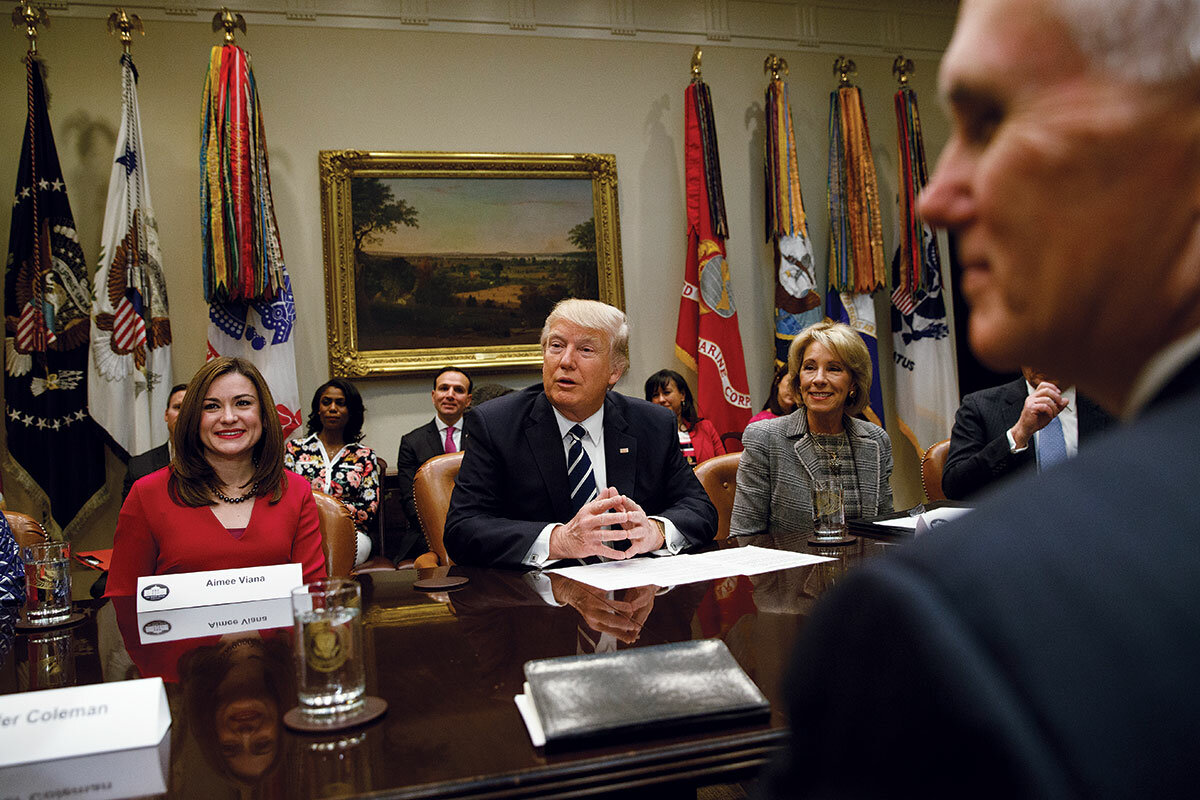
But critics say Mr. Trump’s agenda is likely to go far beyond what outside groups are planning. He has already floated at least one policy idea that even his allies at Heritage rejected as “terrible”: the creation within the federal government of a “credentialing body” that would “certify teachers who embrace patriotic values [to] support our way of life.”
“Left to his own devices, he would become a dictator in that he would ignore constitutional protections and the rule of law,” says Matthew MacWilliams, a scholar of authoritarianism and author of “On Fascism: 12 Lessons From American History.”
One of Mr. Trump’s first actions as president was something ruled unconstitutional. On Jan. 27, 2017, he signed an order that prohibited foreign nationals from seven predominantly Muslim countries from entering the U.S. for 90 days. It sparked widespread protests, some at airports, and was blocked by federal courts as an infringement of the First Amendment guarantee of equal treatment of religion under the law.
A second, narrower attempt at a ban met the same fate. A third, revised ban was eventually upheld by the Supreme Court more than a year later.
Since then, the Supreme Court has shifted in a more conservative direction, due to President Trump’s three appointments. And the congressional GOP has also shifted in a pro-Trump direction as moderate and establishment Republicans have retired or lost primaries. The experienced officials who helped fill the top ranks of President Trump’s first administration – and at the time sought to head off what they viewed as bad policy moves – would be replaced in any second term by Trump loyalists.
“Last time, there were people in different institutions that stopped him,” says Dr. MacWilliams of controversial actions. “But those guardrails are gone.”
Media alarms
Much of the national discussion about the possibilities and perils of any return of Donald Trump has been driven in recent weeks by a series of dire mainstream media reports and opinion pieces on the subject.
In mid-November, The Economist published a lead editorial titled “Donald Trump poses the biggest danger to the world in 2024,” focused largely on his possible effect on world events. The Washington Post around the same time ran a long piece headlined “Trump and allies plot revenge, Justice Department control in a second term.” The New York Times ran a series of reported pieces on how Mr. Trump plans to wield power if reelected.
At the end of November, Mr. Kagan’s essay in the Post – titled “A Trump dictatorship is increasingly inevitable. We should stop pretending.” – had a scarifying effect on many Democrats and anti-Trump Republicans. The doorstopper to this point is The Atlantic’s special issue of 24 stories by staff writers and contributors, titled simply “If Trump Wins.”
It is important to remember that deeming an idea bad does not mean it is dictatorial. One may oppose cutting or raising taxes, but those are typical policy plans. A number of Mr. Trump’s floated ideas appear to be as much rally applause lines as actual proposals, and would be difficult to initiate, at best. How would a “credentialing body” to ensure teachers have “patriotic values” – which is part of Mr. Trump’s published education agenda – even work?
That said, there are at least three types of Trump proposals mentioned throughout the reporting on what might happen in a possible second term that experts on democracy and autocracy deem alarming.
One is Mr. Trump’s evident desire to use the Department of Justice to enact revenge on his enemies and the perceived enemies of his supporters, including those who have been prosecuted for their actions on Jan. 6.
“I am your justice. And for those of you who have been wronged or betrayed, I am your retribution,” he said at his kickoff campaign rally in Waco, Texas, this spring.
Such a move would build on efforts Mr. Trump made in his first term to get prosecutors to pursue some of his enemies, such as his public demand in 2017 that the Justice Department open an investigation into the FBI’s scrutiny of his campaign’s contacts with Russia. Attorney General William Barr appointed a special counsel to investigate the origins of the Trump-Russia probe in 2020.

Breaking down the wall between the White House and the Department of Justice would shatter the post-Watergate norm of federal prosecutorial independence once and for all.
Mr. Trump has said publicly that if he wins a second term, he intends to appoint a “real special prosecutor” to pursue President Biden and his family. The Washington Post has reported that he has plans to order investigations into some of the former officials and allies who have turned on him, such as former Attorney General Barr, ex-chief of staff Kelly, and ex-Trump White House lawyer Ty Cobb.
Current Trump aides and defenders justify such potential moves by saying turnabout is fair play. President Biden is the real “dictator,” they argue, because his administration initiated the federal prosecution of Mr. Trump, his almost-certain opponent in the fall election. They dismiss Biden administration assertions that the president has had no role in the prosecution decisions of special counsel Jack Smith, who has filed criminal charges against Mr. Trump over his actions surrounding the 2020 election as well as his handling of classified documents.
A second Trump proposal that some experts say could be damaging to U.S. democracy is the possible expanded use of uniformed military forces for domestic law enforcement.
It is generally illegal to use federal troops in police actions on U.S. soil. There is, however, a law that allows exceptions: the Insurrection Act, which empowers presidents to declare emergencies and deploy regular military and federalized National Guard troops in cases of riots and other sorts of unrest in the states.
As president, Mr. Trump threatened to invoke this law in response to public Black Lives Matter demonstrations following the murder of George Floyd, who was Black, by a white Minneapolis police officer. The demonstrations were largely peaceful, but some turned violent.
Mr. Trump declared in June 2020 that if a city or state did not suppress violent demonstrations, “I will deploy the U.S. military and quickly solve the problem for them.” He walked back from that line, but his supporters are reportedly drawing up plans to invoke the Insurrection Act as early as the first day of any second term. That would raise the specter of using regular U.S. military units against civil demonstrations, including any protests that might arise if he were elected.
Campaigning in Iowa last year, Mr. Trump said he was blocked from using the military in Democratic states and cities when in office but that this wouldn’t happen in a second term. He called Chicago and New York “crime dens” and said, “The next time, I’m not waiting,” implying he might send in troops over the objections of local authorities.
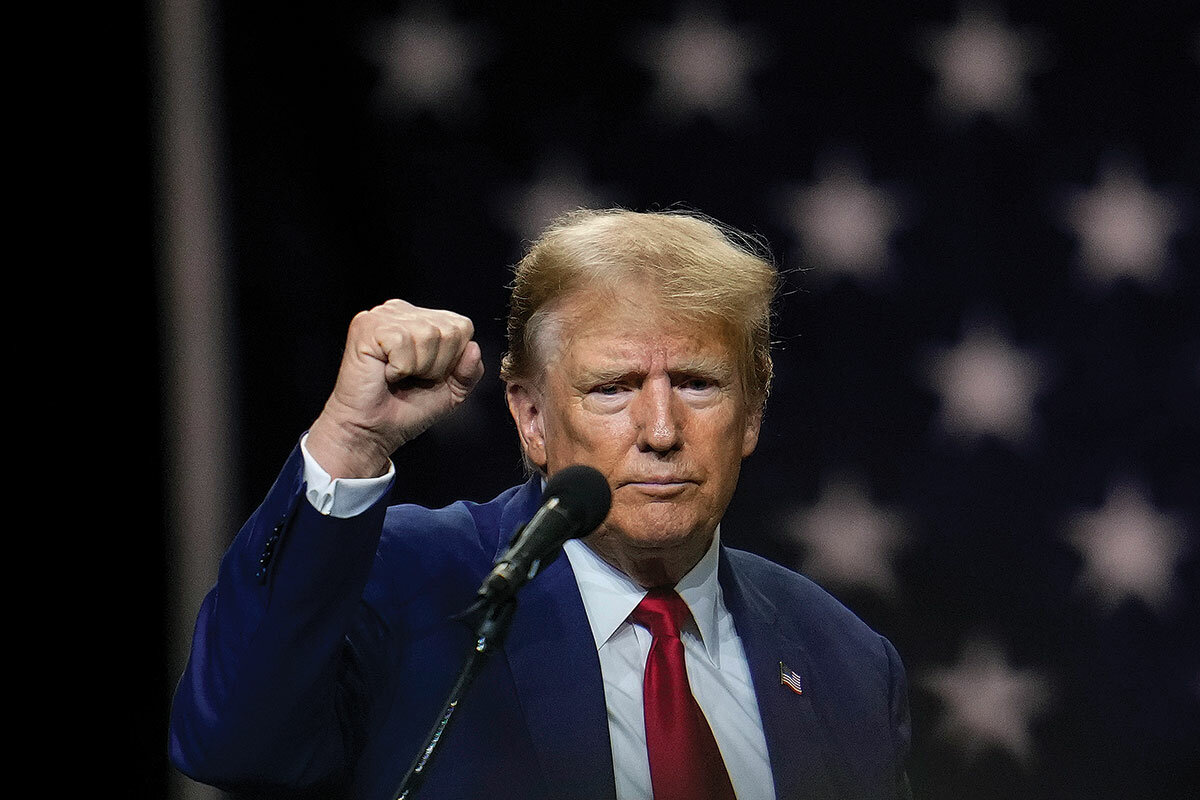
The “Schedule F” plan
A third Trump proposal critics find problematic is a plan to fire thousands of civil service workers and replace them with known Trump supporters in an attempt to do away with an alleged “deep state” of executive branch liberals. Podcast host Steve Bannon and other former Trump aides have long blamed a shadowy administrative state for working against Mr. Trump’s policy goals during his presidency.
“This is the final battle,” Mr. Trump told a Republican convention in Greensboro, North Carolina, in June. “We will demolish the deep state. We will expel the warmongers from our government. We will drive out the globalists; we will cast out the communists; we will throw off the sick political class that hates our country.”
Mr. Trump and his allies are reportedly planning to reclassify upward of 50,000 federal employees, stripping them of existing employment protections so they could more easily be fired and replaced with loyalists. By way of contrast, under current law new presidents get to replace about 4,000 political appointees.
The means to accomplish this would be an executive order creating a new “Schedule F” civil service level of replaceable personnel. As president, Mr. Trump signed such an order in his waning days, but it was overturned by incoming President Biden.
Mr. Trump might have had some reason to be frustrated with the bureaucracy he inherited. According to the pro-Trump group America First Policy Institute, some U.S. workers resisted implementing orders during President Trump’s administration. Federal attorneys refused to work on cases charging Yale University with discrimination against Asian Americans, according to AFPI, and Environmental Protection Agency officials did not inform political appointees about major upcoming cases.
But many of Mr. Trump’s initiatives might be harder to carry out than their architects realize.
It’s not difficult to imagine the reclassification and firing of tens of thousands of federal workers as spiraling into chaos, for example.
Civil service employees have extensive legal job protections. Washington is full of lawyers whose specialty is litigation of issues surrounding federal employment. They would pounce on an executive order that attempts to overturn decades of established regulations.
“I think there would be a barrage of court challenges,” says Kathryn Dunn Tenpas, a Brookings Institution Governance Studies visiting fellow.
Any mass firings of government workers or widespread turmoil in the bureaucracy could lead to a serious disruption in government services, says Steve Lenkart, executive director of the National Federation of Federal Employees. Replacements chosen for loyalty to Mr. Trump instead of fitness for the job might be of little help.
“They really want to strip down the civil service in every possible way they can,” says Mr. Lenkart.
On the other hand, many of Mr. Trump’s aides and supporters might not be opposed to a hobbled or immobilized government.
“The one thing we learned in the Trump administration the first go-round is we’ve got to put in all-America patriots top to bottom,” said former Trump Defense Department official Kash Patel during an appearance on Mr. Bannon’s “War Room” podcast in early December.
During the same show, Mr. Patel added the media to the list of Trump 2.0 targets, saying they would retaliate against media figures who had “conspired” with President Biden to “rig” the 2020 election.
There remains no evidence that any election-changing voting fraud occurred in any state in 2020.
“We’re going to come after you whether it’s criminally or civilly. We’ll figure that out,” said Mr. Patel, currently a senior fellow at the Center for Renewing America, a conservative think tank associated with preparations for a second Trump White House.
Mr. Patel is widely thought to be on Mr. Trump’s shortlist for CIA director or some other top post during a second Trump term. The Trump campaign disowned his statements from the “War Room” podcast, however, saying it has “nothing to do with” assertions like that.
Mr. Trump has long used the media as a political foil, slamming them as “enemies of the people.” Late last year, he complained about MSNBC’s election coverage and threatened to “make them pay for their illegal political activity.” There seems little doubt that a Trump administration would turn the knob up on anti-press animus in a second term.

Today’s news briefs
• Iran bombings: The Islamic State claims responsibility for Wednesday’s suicide bombings in Iran. The group likely hopes to take advantage of the chaos gripping the region amid Israel’s war on Hamas.
• Russia-Ukraine prisoner exchange: Some 230 Ukrainian and 248 Russian prisoners of war return home in the biggest single release of captives since Russia’s invasion in February 2022.
• Justice Department sues Texas: A federal lawsuit targets a new Texas law that will allow state police to arrest people crossing the border illegally. It accuses Texas of violating the U.S. government’s authority over immigration enforcement.
• Egypt’s new capital: Egypt is preparing to spend billions of dollars doubling the size of a lavish new capital it is building in the desert 28 miles east of Cairo. The first residents are now moving in.
• “Unbeatable” game beaten: A 13-year-old has become the first player to officially beat the video game Tetris, causing it to glitch and crash – a highly coveted achievement in the video game world.

Harvard president steps down: Why charges of plagiarism stick
In the era of artificial intelligence, plagiarism can seem like an old-fashioned charge. But in the circles of academia, it still has teeth – and for good reason.
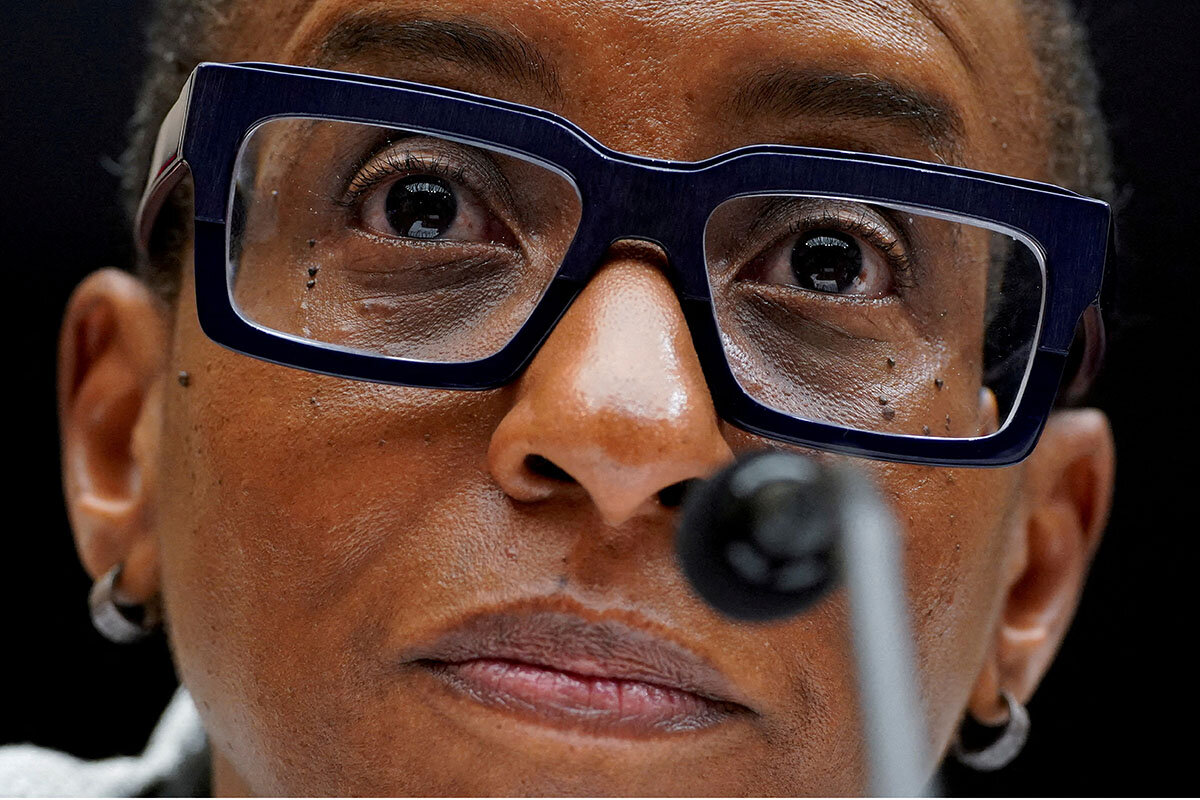
- Quick Read
- Deep Read ( 5 Min. )
-
Harry Bruinius Staff writer
Claudine Gay, the second woman to hold the title of president of Harvard, and the first Black person, ended the shortest tenure in the university’s history on Jan. 2.
The sought-after post of university president has become fraught in a time when higher education is increasingly a target. After a disastrous congressional hearing in December, Liz Magill resigned as head of the University of Pennsylvania. And in July, Stanford University’s Marc Tessier-Lavigne had to step down after an independent review found significant flaws in his research going back decades.
Dr. Gay is hardly the first prominent scholar to deal with allegations of insufficient attribution. Others include Supreme Court Justice Neil Gorsuch, Pulitzer Prize-winning historian Doris Kearns Goodwin, and primatologist Jane Goodall. Dr. Gay is not accused of stealing ideas or artistic expression – which experts consider the most serious ethical lapses – but rather carelessness. In the circles of academia, plagiarism is a charge that remains a potential career-killer.
Critics of Dr. Gay say it would be hypocritical for presidents to be held to lesser standards than undergraduates. Dr. Gay and her supporters say that the charges were merely the lever for right-wing activists to oust her for political purposes.
Harvard president steps down: Why charges of plagiarism stick
In the end, it was all about Claudine Gay’s words. Words that she did and didn’t say during a Dec. 5 congressional hearing in Washington. Words that she used in research without proper attribution.
Jewish students questioned if Dr. Gay could keep them safe on campus in the face of antisemitism. Billionaire Harvard alum Bill Ackman claimed that Dr. Gay only got her job because she was a diversity, equity, and inclusion hire.
Dr. Gay, only the second woman to hold the title of president of Harvard, and the first Black person, ended the shortest tenure in the university’s history on Jan. 2.
“Yes, I made mistakes,” Dr. Gay wrote in The New York Times. “My commitment to fighting antisemitism has been questioned. My inbox has been flooded with invective, including death threats. I’ve been called the N-word more times than I care to count.”
Calls for her departure rose in the wake of her testimony before Congress. Shortly after, her scholarship was questioned, specifically missing quotation marks or attribution. Scholars argued if she should stay or go. The Harvard Corp. announced to the faculty that she had been cleared of plagiarism accusations and simply made a few instances of inadequate citations. Then, more instances of inadequate citation came to light.
“It was clear that there were people attacking the university who had her in their sights and were determined not to let up pressure on her to resign,” says Alison Frank Johnson, a Harvard history professor who joined more than 700 other faculty members in signing a letter in support of Dr. Gay in December.
The sought-after post of university president has become fraught in a time when higher education is increasingly a target. After the congressional hearing, Liz Magill resigned as head of the University of Pennsylvania. And in July, Stanford University’s Marc Tessier-Lavigne had to step down after an independent review found significant flaws in his research going back decades.
Dr. Gay is hardly the first prominent scholar to deal with allegations of insufficient attribution. Others include Supreme Court Justice Neil Gorsuch, Pulitzer Prize-winning historian Doris Kearns Goodwin, and primatologist Jane Goodall. Dr. Gay is not accused of stealing ideas or artistic expression – which experts consider the most serious ethical lapses – but rather carelessness. In the circles of academia, plagiarism is a charge that remains a potential career-killer.
“The ability to think critically and independently is a crucial skill for students and faculty alike. Copying work from others, without proper acknowledgment or citation remains a major issue of academic integrity and obviously discourages critical thinking,” says Alan Kadish, president of Touro University, via email. “Despite the advances in large language processing artificial intelligence, we should insist that while using prior sources students must think and write on their own. ... The ability to reason remains crucial to educational and professional growth.”
Critics of Dr. Gay say it would be hypocritical for presidents to be held to lesser standards than undergraduates. Dr. Gay and her supporters say that the charges were merely the lever for right-wing activists, such as Christopher Rufo, to oust her for political purposes.
“As I depart, I must offer a few words of warning. The campaign against me was about more than one university and one leader. This was merely a single skirmish in a broader war to unravel public faith in pillars of American society,” Dr. Gay warned in the Times.

Dr. Johnson was shocked that the Harvard Corp. did not give Dr. Gay due process. She says that in a late December meeting with faculty members, Dr. Gay assured them that she was preparing to weather the storm.
“I thought that the plagiarism allegations would be reviewed, as is common practice in academia when there are such allegations, by a committee that would do a thorough investigation, that would determine whether or not they were really serious enough to merit some kind of response,” Dr. Johnson says.
She adds that while mistakes are a part of science, plagiarism and scholarly misconduct cannot be tolerated, especially by a university president. But due process includes peer review, which Dr. Gay did not receive. Peer reviewers use scholarly principles and practices to determine if mistakes reach the level of research misconduct or if they are just regrettable errors, she says.
“I just expected the process to play out more slowly and to involve more serious and careful consideration within the university, rather than what seems to me to be a sudden response to just relentless outside pressure,” Dr. Johnson says.
According to the Harvard Guide to Using Sources, plagiarism means to draw any idea or any language from someone else without adequately crediting that source. Taking credit for someone else’s work is stealing and is unacceptable in all academic situations, intentionally or not.
“In the digital age, it is much easier to share and copy information seamlessly. However, thus far the standards for acknowledgment, sharing, and plagiarism have not materially changed,” says Dr. Kadish. “Although there has been some disagreement about the severity of copying phrases, the lack of acknowledgment in President Gay’s work, the pervasive nature of it ... is worrisome. I believe that her resignation was an affirmation of the need to maintain high standards in our nation’s institutions of higher learning.”
Still other scholars point to racial targeting for Gay’s resignation.
“The question to assess whether this was a racist attack is not whether President Gay engaged in any misconduct. The question is whether all these people would have investigated, surveilled, harassed, written about, and attacked her in the same way if the Harvard president in this case would have been White. I. Think. Not,” Ibram X. Kendi, founder of the Center for Antiracist Research at Boston University, posted on social media.
Students on the Harvard campus, whether they support Dr. Gay or feel she needed to step down, repeatedly have spoken about their exhaustion and a need for the university to champion its own ideals.
“Public trust in elite institutions like our own has long been in decline. In many ways, it produced the controversy with Gay that now steepens the nosedive,” writes The Harvard Crimson in an editorial. “To stanch this existentially threatening trend, Harvard must commit to public accountability and transparency.”
Some students, too, point to ulterior motives behind the ouster of Dr. Gay.
“The criticisms she faced had merit, but their merits did not end her presidency – a campaign of ugly and racist political opportunism did,” writes the Crimson. “This is an assault on higher education. It employs the cheapest, most foul tactics American politics has to offer. And it will not end with Claudine Gay’s presidency.”

Gaza war: Why Houthis pose tough challenge to US in Red Sea
From Lebanon to Iraq and Yemen, attacks by the Iran-led “Axis of Resistance” have raised concerns that the Israel-Hamas war could escalate into a regional conflict. In the Red Sea, a U.S. bid to secure shipping lanes faces a determined adversary.

- Quick Read
- Deep Read ( 5 Min. )
American helicopters answering a distress call from a cargo ship early Sunday came under fire from Houthi boats in the Red Sea, the U.S. military said. And in the first direct lethal contact of its kind since U.S. forces sought to secure the key global shipping route during the Israel-Hamas war in Gaza, the U.S. military says it killed 10 Houthi sailors and sank three out of four small Houthi boats.
Houthi officials vowed revenge, and two ballistic missiles were fired into the area late Tuesday. In turn, the White House warned Wednesday that the Houthis would face “consequences” if they did not stop their attacks.
The military encounters are adding to the risk of a regional escalation of the Gaza war. The Iran-backed Houthis, part of the Iran-led “Axis of Resistance,” have vowed to target commercial ships linked to Israel until the Jewish state stops its war in Gaza.
Analysts say the Houthis’ armed faceoff with American warships and helicopters boosts the militia’s bona fides.
“The Houthis are intoxicated by their new status,” says Abdulghani al-Iryani at the Sana’a Center for Strategic Studies. “Taking on the Americans has symbolic value. ... They will continue to fire missiles at ships and disrupt the flow of commerce.”
Gaza war: Why Houthis pose tough challenge to US in Red Sea

Increasing military encounters between U.S. naval forces and Yemen’s Houthi fighters in the Red Sea are jeopardizing a key global transport route and adding to the risk of a regional escalation of the Israel-Hamas war. The Iran-backed Houthis have vowed to target commercial ships linked to Israel until the Jewish state stops its war in Gaza.
In the first direct lethal contact of its kind, the U.S. military says it killed 10 Houthi sailors and sank three out of four small Houthi boats that were attacking the Maersk Hangzhou cargo vessel in the southern Red Sea after dawn Sunday.
American helicopters answering a distress call from the ship came under fire from Houthis, the U.S. Central Command said on X, formerly Twitter.
Houthi officials vowed revenge, and two ballistic missiles were fired into the area late Tuesday – the 24th such Houthi attack directed against Red Sea shipping since Nov. 19, when helicopter-borne Houthi fighters hijacked the vessel Galaxy Leader and took its crew of 25 hostage.
The White House Wednesday, in a joint statement with 12 other nations, warned that Houthis would face “consequences” if they did not stop the “illegal, unacceptable, and profoundly destabilizing” attacks.
But analysts say the Houthis’ armed faceoff with American warships and helicopters, in the name of defending Palestinians in Gaza, boosts the militia’s bona fides and provides another means that the Iran-led “Axis of Resistance” – which includes the Houthis – challenges Israeli and U.S. influence in the region.
Indeed, the latest flare-up indicates that the Houthis remain undeterred by a maritime coalition of several nations created in December and led by the United States.

“The Houthis are intoxicated by their new status,” which they will be reluctant to relinquish, says Abdulghani al-Iryani, a senior researcher of the Sana’a Center for Strategic Studies. “Now that they have gotten into the game, and shown that they can have an impact, if they withdraw, their PR loss will be massive.
“Taking on the Americans has symbolic value,” Mr. Iryani says. There are no “obvious” Houthi targets for the U.S. to strike, and taking out leadership members “will only increase the credibility of the Houthi movement, make them stronger, make their popular support higher. So I think they [the Houthis] are looking forward to American strikes,” he adds.
“Maybe they will not expand the range of their operations,” he says. “To hijack another vessel is too difficult now with all these warships roaming around. But they will continue to fire missiles at ships and disrupt the flow of commerce.”
The latest incidents are textbook examples of how actions in the Red Sea can escalate in a flash from calibrated to dangerous, with ramifications far beyond the Israel-Hamas conflict, which erupted Oct. 7.
From the start of that war, Houthis have fired drones and missiles at Israel from 1,000 miles away – most of them shot down by American and British ships, or by Israeli air defenses – in solidarity with Palestinians and Iran’s “axis.”

Other recent events highlight the regional reach of the Gaza war.
The most powerful wing of the loose Iranian alliance, Lebanon’s Hezbollah militia, raised the specter of expanding the war on Israel’s northern border after a senior Hamas leader, Saleh al-Arouri, was assassinated in a drone strike Tuesday in a Beirut suburb.
Hezbollah leader Hassan Nasrallah said Wednesday that the killing was a “flagrant Israeli aggression,” about which “we cannot be silent.” After almost three months of near-daily cross-border artillery and rocket exchanges with Israel, he did not order a surge, but said Hezbollah would fight with “no rules” if Israel launched a war on Lebanon.
And in Iraq, a U.S. military drone Thursday killed a leader of the al-Nujaba militia in eastern Baghdad. The U.S. blames the Iran-backed group for some of the 100 attacks carried out against the U.S. military in Iraq and Syria since Oct. 7.
“We will retaliate and make the Americans regret carrying out this aggression,” local militia commander Abu Aqeel al-Moussawi told Reuters.
Just over a week earlier, in Syria, Israel killed a senior adviser of Iran’s powerful Islamic Revolutionary Guard Corps in an airstrike outside Damascus. Razi Mousavi was reportedly responsible for coordinating the Syria-Iran military alliance, and was hailed by Iranian state-run media as a trusted companion of Maj. Gen. Qassem Soleimani – the Iranian architect of the “Axis of Resistance” who was killed in an American drone strike in 2020.

Tension in the region grew further Wednesday, when two bombs in the southeastern Iranian city of Kerman exploded, killing 84 mourners who had gathered near the grave of General Soleimani to mark four years since his death. Some Iranian officials publicly blamed Israel and the U.S. and vowed to retaliate, though the Islamic State claimed responsibility Thursday for the attack.
In the Red Sea, meanwhile, experts say that, despite the presence of the U.S.-led maritime coalition, global shipping has been disrupted. One in 5 vessels that would have passed through the Bab el Mandeb Strait and sailed up the Red Sea and through Egypt’s Suez Canal – where 12% of global seaborne trade typically passes – are now taking the much longer and costlier route around southern Africa, they say.
“Even if America succeeds in mobilizing the entire world, our military operations will not stop ... no matter the sacrifices it costs us,” Mohammed al-Bukhaiti, a senior Houthi official, wrote on X after the creation of the U.S.-led coalition.
The Houthis would only stop their attacks, he said, if Israel’s “crimes in Gaza stop and food, medicines, and fuel are allowed to reach its besieged population.”
Houthi military losses, such as the 10 fighters killed by the U.S. in the Red Sea, enhance the group’s reputation and pale in comparison with the losses of nearly a decade of civil war, says Mr. Iryani of the Sana’a Center.
“The Houthis are willing to pay 10,000 times that to get this kind of political capital and credibility,” he says. “We’ve lost at least 400,000 lives [in Yemen since 2014], so a few tens of thousands more – it’s nothing to them.”


In Russia Expo, a look at what Putin wants his country to be
The new Russia Expo is offering the country’s public a view of its many regions and cultures. But experts say it also offers a window into Vladimir Putin’s vision of Russia’s present and future.

- Quick Read
- Deep Read ( 5 Min. )
Since November, more than 4 million Russians have passed through the exhibits of the new Russia Expo, a collection of 130 colorful, innovative, and surprisingly upbeat exhibits spread over nearly 600 acres of exhibition grounds in Moscow.
Some analysts suggest that the show is the very embodiment of Russian President Vladimir Putin’s electoral program in the upcoming reelection campaign, with voting to be held on March 17. They say it aims to knit Russia’s past and present into a single continuum of great achievements, with the emphasis on building a bright, unified, and prosperous future.
Andrei Kolesnikov, a Carnegie fellow who continues to live and work in Russia, says the expo is an old Soviet form that’s been reinvented, modernized, and put to work to project Mr. Putin’s current vision of where Russia is headed.
“It’s not a coincidence that [a former Soviet exhibition site] was chosen for this purpose,” he says. “The grounds are filled with traditional symbols of Russian empire and achievement. The current message is that ‘everything is OK; these are peaceful times. Putin can wage war in Ukraine, and develop Russia as well. We don’t need the West; we can do it ourselves.’”
In Russia Expo, a look at what Putin wants his country to be

With the onset of the holiday week between New Year’s Day and Orthodox Christmas, Russians have been thronging the halls of the new Russia Expo, a collection of 130 colorful, innovative, and surprisingly upbeat exhibits spread over nearly 600 acres of exhibition grounds.
More than 4 million visitors have passed through the exhibits representing every Russian region, plus four occupied Ukrainian territories and Crimea, that make up the new Russia Expo, which runs from November to April.
That timetable also happens to coincide with the upcoming Russian presidential election campaign – with voting to be held on March 17 – in which incumbent Vladimir Putin is considered the top contender. After his first visit to the exhibition in early December, Mr. Putin seemed so pleased that he told a group of foreign ambassadors that they should also visit so that “you can see with clear examples how Russia is developing, how it lives.”
Some analysts suggest that the show is the very embodiment of Mr. Putin’s electoral program, aiming to knit Russia’s past and present into a single continuum of great achievements, with the emphasis on building a bright, unified, and prosperous future.
“The central image on display at the exhibition is the success of Putin-era Russia. You see it reflected in every exhibit, in a multiplicity of ways,” says Alexei Mukhin, director of the Center for Political Information, an independent think tank. “The unspoken message of holding this big show at such a time is to demonstrate that Russia can wage war and deliver domestic prosperity at the same time. Outwardly, this exhibition is a clear projection of Putin’s vision for Russia’s future, and he is positioned as the person who changed Russia and makes that future possible.”
A distorting mirror
The expo is being held on the sprawling grounds of the former Soviet Exhibition of Economic Achievements (known by its Russian acronym, VDNKh), which features vast green spaces and about 400 buildings, including many ornate Josef Stalin-era constructions that were built to highlight the former USSR’s achievements, including space, atomic energy, industry, and arts.
The original Soviet exhibition was established in the 1930s to convince the population that the hard times of revolution, civil war, and famine were over and a bright communist future beckoned. After World War II, it was repurposed and expanded to showcase Soviet achievements in science, industry, and technology. It was modeled on the concept of a world’s fair, but one that would encapsulate the globally isolated Soviet Union, with its 15 diverse republics supposedly united by socialist ideology and scientific dynamism. Following the collapse of the USSR, the vast grounds fell into disrepair, and many of the pavilions were used by commercial companies to warehouse and market a bewildering array of goods.

At every point, the VDNKh exhibitions served as an invitation to the population to come and embrace the state’s vision of itself, says Pavel Nefedov, curator of the museum.
“This place has always been supported by the state, and it owes its continued existence to that,” he says. “In its original conception, it represented Utopia built on a limited territory. For the visitors, visiting the exhibition was a kind of symbolic reward. It was always a mirror held up to the country, but not one that reflected things as they were, but as the state thought they should be.”
Even in the 1990s, when a veritable bazaar sprang up on VDNKh’s ruins, “it reflected the dominant idea of the time, a commercial marketplace. The communist symbols became vending platforms,” Mr. Nefedov says.
In recent years, the Russian government has spent considerable sums renovating the territory and kept it open for people to roam the grounds. But until the Russia Expo was announced, the place seemed without purpose.
Broadening the outlook?
The present exhibition looks very much like a Putin-era reincarnation of its Soviet predecessor, with entries from 84 regions of Russia, plus five annexed Ukrainian regions, and pavilions for several major state corporations. It exudes a more festive atmosphere than the old Soviet fair did, with updated presentations that include holograms, robots, interactive displays, and a parade of associated events such as daily lectures, seminars, and forums on a wide variety of (mostly nonpolitical) topics.
It’s not clear how much the Kremlin has spent to stage this show, but figures mentioned in the Russian media suggest it’s at least $60 million.
It has attracted huge crowds in its first several weeks, including large organized tours of schoolchildren. Nadya Titova, a journalist’s field assistant, says the fair appeals as a travel substitute.
“Now that our borders are closed, people have less opportunity to travel abroad, so they are turning inward, wanting to see more of Russia,” she says. “An exhibition like this broadens the outlook, and maybe gives an idea of how many interesting Russian tourist destinations are still accessible.”
The regional displays include attractions such as watching a simulated volcanic eruption in the Pacific territory of Kamchatka, taking tea in a Buryatian yurt, virtual river rafting in Krasnoyarsk, and listening to a robot explain the history of Birobidzhan, a Jewish autonomous region near the Chinese border where Yiddish is an official language.
The Crimea pavilion features a giant replica of the 12-mile-long Kerch Bridge – which has been the target of Ukrainian attacks – and an array of special effects designed to create the audiovisual, tactile, and even olfactory atmosphere of that annexed Ukrainian region, which hopes to become Russia’s premier tourist destination once the war ends.
The continuing war is a mostly silent subtext at the exhibits of the four Ukrainian regions that Mr. Putin declared officially annexed by Russia just over a year ago. The Donetsk pavilion features a “coal mountain” with a “time tunnel” that shows the region’s progression from czarist times, through Soviet-era industrialization, to its “trial by fire” as a separatist region at war with Ukraine and its projected bright future as a province of Russia. The half-occupied Ukrainian region of Kherson features its agricultural potential and nature reserves, which – left unmentioned – are not presently safe to visit.
“Not a coincidence”
Andrei Kolesnikov, a Carnegie fellow who continues to live and work in Russia, says the exhibition is an old Soviet form that’s been reinvented, modernized, and put to work to project Mr. Putin’s current vision of where Russia is headed.
“It’s not a coincidence that VDNKh was chosen for this purpose,” he says. “The grounds are filled with traditional symbols of Russian empire and achievement. The current message is that ‘everything is OK; these are peaceful times. Putin can wage war in Ukraine, and develop Russia as well. We don’t need the West; we can do it ourselves.’”
The Putin-era social contract, in which people pursue their private lives but stay out of politics, has been slightly amended, he says. “Now you don’t need to go to the trenches, but in return you must demonstrate your patriotism. Vote for Putin. Pay for a quiet life. Accept the new balance between war and normality.”
Yaroslav Listov, a Communist Party deputy of the Duma, offers a more prosaic complaint.
“To what extent do these displays correspond to real achievements?” he says. “It’s apparently costing a lot. Wouldn’t it be better to spend this money actually improving peoples’ lives than on expensive demonstrations of how life is supposedly being improved?”

Points of Progress
Where old ideas fuel modern solutions
From “ice stupas” in India to water purification systems for members of the Navajo Nation in the United States, modern solutions to water woes are drawing inspiration from local artistic traditions. A progress roundup.
Where old ideas fuel modern solutions
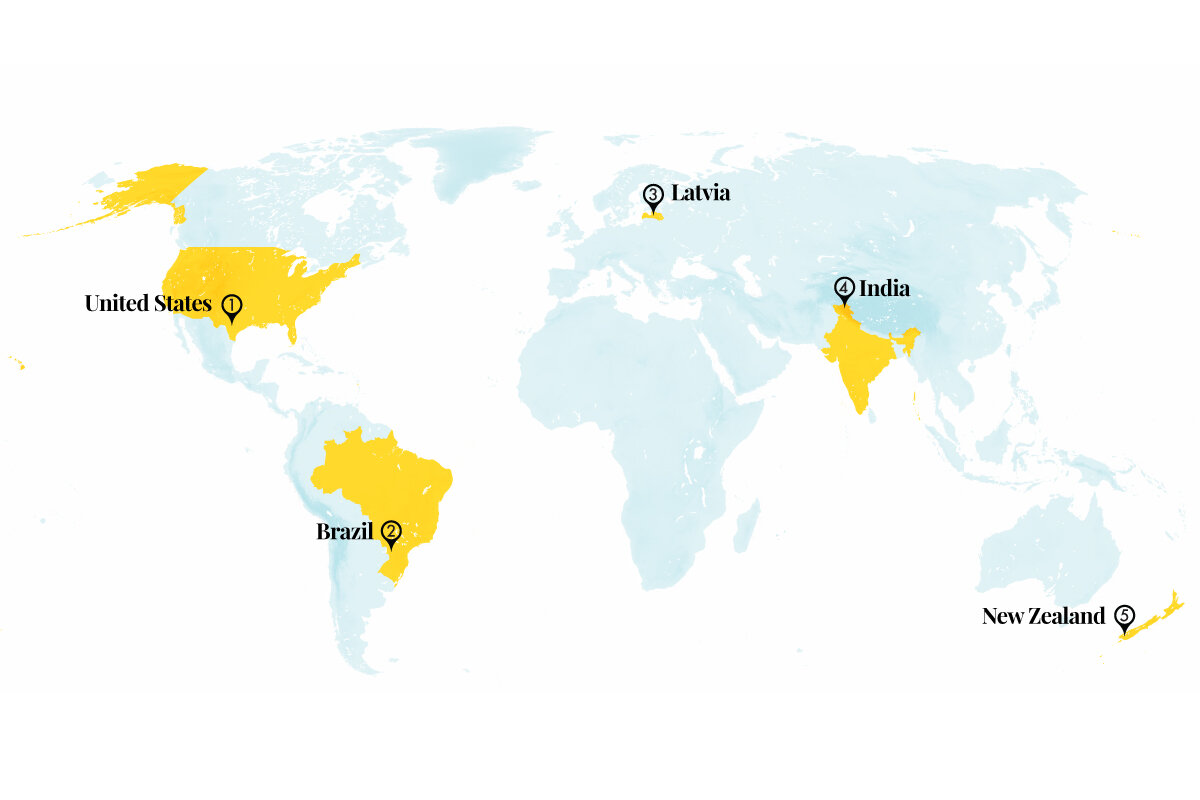
1. United States
A home water treatment using Navajo pottery combines novel engineering with Native American knowledge. After decades of commercial mining in the area, much of the Navajo Nation in the Southwest lacks access to clean drinking water. So scientists from the University of Texas at Austin partnered with a third-generation Navajo potter, Deanna Tso, to create a solution that combines locally sourced pine resin with silver nanoparticles for purification.
While silver is often used in ceramic water filters due to its antimicrobial properties, some filters can quickly lose their effectiveness as silver particles degrade. By incorporating pine resin, a material commonly used as a glaze by Navajo potters, that degradation can be remediated.
Each pot cost less than $10 to create, making it a potentially low-cost solution for those without access to clean water. The lab hopes to develop other technologies for Indigenous communities in Alaska, southern Mexico, and Bangladesh.
“The uniqueness of this technology is its integrated knowledge of the target community and consideration of their cultural norm and ethos prior to designing a solution for them,” said Navid Saleh, a co-author of the paper and whose course teachings have included implementation of science in underserved communities. “This is one of the strengths that most technologies do not do.”
Sources: University of Texas Libraries, American Society of Mechanical Engineers
2. Brazil

Indigenous teens are using artificial intelligence tools to keep their language alive. Of Brazil’s estimated 202 Indigenous languages, the majority are at risk of dying out. But teenage members of the Guaraní people in central South America are using a chatbot to improve their writing skills.
The computer app works similarly to the autocorrect and text suggestion features that are ubiquitous on smartphones. While the students speak Portuguese and Mbayá Guaraní, they default to writing in Portuguese. The app helps students build on Mbayá sentences they begin writing themselves. Led by AI specialist Claudio Pinhanez, the project is part of an IBM initiative to preserve and increase use of Indigenous languages in Brazil. After one semester, the students have started writing longer sentences in Mbayá on their own, said Dr. Pinhanez.
Researchers say that it’s essential for Indigenous communities to be given more high-tech training and stewardship over the development of new tools. In the United Nations’ observance of 2022-2032 as the International Decade of Indigenous Languages, the organization urges large tech companies to help spread the use of such languages and engage the affected communities.
Sources: Reasons to Be Cheerful, UNESCO
3. Latvia
Latvia’s parliament legalized same-sex civil unions. The new legislation allows same-sex couples to officially register their partnerships, affording hospital visitation rights as well as tax and social security benefits. Inheritance and adoption rights remain reserved for married couples, which in 2005 the Latvian constitution defined as a man and a woman. The law will come into force in mid-2024.
While a 2019 Eurobarometer poll found that 45% of Latvians would be uncomfortable having a gay or bisexual high-ranking official, the country earlier this year became the first Baltic nation with an openly gay head of state after parliament voted for Edgars Rinkēvičs as president. Mr. Rinkēvičs served as the foreign minister for over a decade and has been a vocal advocate for LGBTQ+ rights since coming out in 2014.
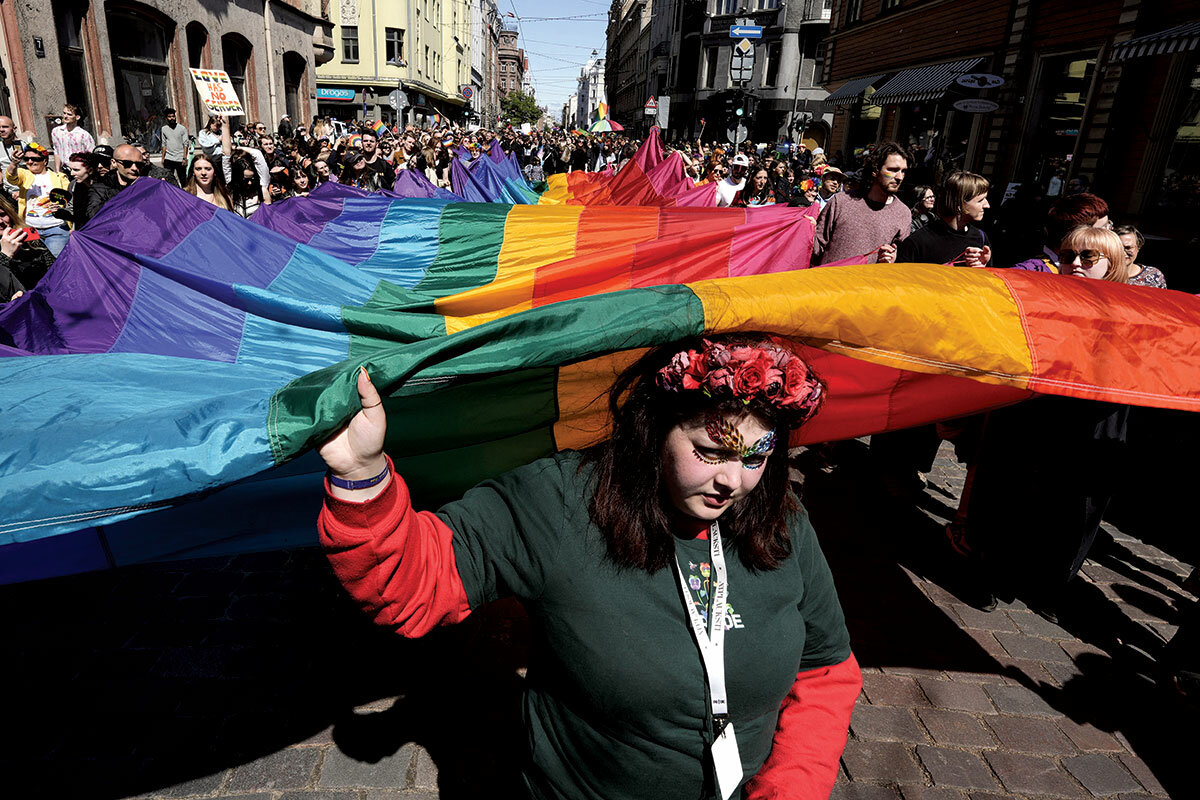
“This is a great beginning,” said activist Kaspars Zalitis. “Latvia is not one of the six countries in the European Union that have no recognition for same-sex couples.” Roughly 40% of Latvians support legalizing same-sex marriage.
Sources: Reuters, Politico
4. India
Indian farmers are building “ice stupas,” artificial mini-glaciers, to combat water scarcity. In Ladakh, a cold desert nestled between the Himalayan and Karakoram mountain ranges, farmers use streams fed by glacial melt to water their crops. But climate change has been shrinking glaciers, and in turn the growing season.
In 2013, Ladakhi engineer Sonam Wangchuk came up with the idea for the ice stupas, named for the conical shape they share with holy sites ubiquitous in the region. He and his students piped water during the rainy season to construct a tower of ice. The tower stayed frozen until spring, melting to feed the streams for irrigation before the supply of glacier water increased in the summer. The vertical shape exposes less surface area to the sun and slows melting, compared with horizontal ice formations. Mr. Wangchuk engaged communities by starting an annual ice stupa-making contest, in which residents learn how to build the towers and compete for cash prizes.
The stupas have limitations, such as vulnerability to flash floods. But in 2022, Chilean engineers built similar ice stupa prototypes in the Andes. They are working on a model that will use artificial intelligence to optimize efficiency. Scientists from New Delhi and Aberdeen, Scotland, are also studying ice stupas to enhance research of natural glaciers.
Sources: The Conversation, Reasons to Be Cheerful
5. New Zealand
The takahē, a bird once thought to be extinct, is returning to the wild in New Zealand. In a country with no native terrestrial mammals, the birds were declared extinct in 1898 after invasive stoats and other animals introduced by British settlers had devastated local bird populations. But a small group of takahē persisted in the Murchison Mountains of the country’s South Island and was rediscovered in 1948.

Since their rediscovery, takahē populations have grown at a rate of about 8% a year to roughly 500. Conservation efforts began by gathering and artificially incubating eggs. Once the eggs hatched, workers fed the chicks using sock puppets bearing the birds’ characteristic scarlet beaks. In August, 18 takahē were released into the lands of the Ngāi Tahu Māori people, whose ancestors gathered the birds’ feathers and wove them into cloaks.
Efforts to reestablish the takahē are part of broadly supported national attempts to eradicate invasive mammals and protect New Zealand’s birds. Most of the species are endemic and had evolved over millenniums to occupy evolutionary niches normally occupied by mammals. The kiwi, the country’s national bird, was reintroduced to the wild near the capital, Wellington, last year.
Sources: The Guardian, Biographic
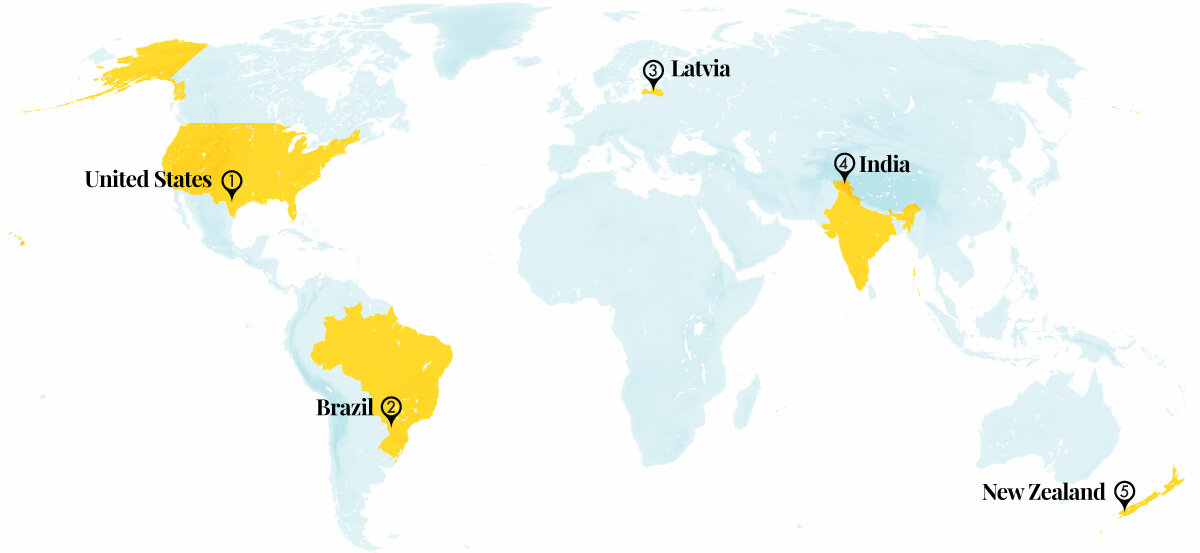
Other headline stories we’re watching
(Get live updates throughout the day.)The Monitor's View
India’s new cadres of equality
- Quick Read
- Deep Read ( 3 Min. )
-
By the Monitor's Editorial Board
In a year of consequential elections in many of the world’s major democracies, one of the most consequential may also be the least climactic. India appears poised to reelect Prime Minister Narendra Modi this spring.
That prospect fuels broad concern for the welfare of global democracy. Already in power for a decade, Mr. Modi has eroded many of India’s constitutional norms such as judicial independence, freedom of the press, and secularism. Along the way, however, he has also been nurturing – perhaps inadvertently – a new democratizing force in Indian politics: women.
Female voters are on course to outnumber their male counterparts within a few years, yet their growing political influence is more than demographic. It reflects a deepening claim by women to their dignity and equality, irrespective of social rank or entrenched patriarchal norms.
Casting a ballot is “the only occasion that a woman voter feels herself to be an equal citizen and takes pride in that,” Annie Raja, general secretary of the National Federation of Indian Women, told Frontline, an Indian magazine. “She literally sees that equality with both men and women standing in lines.”
India’s new cadres of equality

In a year of consequential elections in many of the world’s major democracies, one of the most consequential may also be the least climactic. India appears poised to reelect Prime Minister Narendra Modi this spring.
That prospect fuels broad concern for the welfare of global democracy. Already in power for a decade, Mr. Modi has eroded many of India’s constitutional norms such as judicial independence, freedom of the press, and secularism. Along the way, however, he has also been nurturing – perhaps inadvertently – a new democratizing force in Indian politics: women.
Female voters are on course to outnumber their male counterparts within a few years, yet their growing political influence is more than demographic. It reflects a deepening claim by women to their dignity and equality, irrespective of social rank or entrenched patriarchal norms.
Casting a ballot is “the only occasion that a woman voter feels herself to be an equal citizen and takes pride in that,” Annie Raja, general secretary of the National Federation of Indian Women, told Frontline, an Indian magazine. “She literally sees that equality with both men and women standing in lines.”
Two factors show how women are building political influence and independence. One is Mr. Modi’s promotion of initiatives based on a concept of service called seva. By equating politics to service, notes Anirvan Chowdhury, a postdoctoral fellow at Harvard University, the prime minister has given political activism a more feminine hue. The local women’s wings of the Bharatiya Janata Party organize health care clinics, tree-planting projects, and cultural celebrations.
“The BJP has seemingly shed its traditional image embodying a muscular and masculine form of Hindu nationalism to gain a significant edge among women voters,” Mr. Chowdhury wrote Wednesday in The Indian Express. “The seva narrative aligns with traditional expectations of women as selfless and self-sacrificing, downplaying the potentially disruptive aspects of increased political agency.” Men, he noted, have been more apt to accept female political participation when it is framed as service.
The other factor relates to political quotas. Last September, India’s Parliament passed a law requiring that a third of all seats in the lower house be reserved for women. It mandates the same level of representation at the state level.
The new quotas must still be passed by the 29 state legislatures and won’t come into effect until at least 2029. A 1993 law that required that women lead local councils in a third of all villages nationwide, meanwhile, has had only a slow upward trickle effect. Women still hold just 14% of seats in Parliament and accounted for only 12% of the candidates in the five state races last month.
But quotas have helped cultivate a sense among women of their right to participate in politics by creating networks of activism that cross India’s social classes. Parties see an advantage to female political activism because women are able to talk more freely than men in more intimate social settings such as homes. That activism is changing perceptions.
“Women politicians need not change deeply entrenched beliefs to mobilize women into politics,” Tanushree Goyal, a political professor at Princeton University, wrote in a paper last fall. Their political activism, she noted, is shifting focus “on what women do when they are in politics, not only what women symbolize.”

A Christian Science Perspective
Each weekday, the Monitor includes one clearly labeled religious article offering spiritual insight on contemporary issues, including the news. The publication – in its various forms – is produced for anyone who cares about the progress of the human endeavor around the world and seeks news reported with compassion, intelligence, and an essentially constructive lens. For many, that caring has religious roots. For many, it does not. The Monitor has always embraced both audiences. The Monitor is owned by a church – The First Church of Christ, Scientist, in Boston – whose founder was concerned with both the state of the world and the quality of available news.
Spirituality: At the heart of healing
- Quick Read
- Read or Listen ( 3 Min. )
-
By Debbie Peck
When the spiritual facts of being become more real to us than what the material senses are reporting, healing happens.
Spirituality: At the heart of healing
I grew up in an extended family that includes more than 30 doctors, but I gained a whole new perspective on preventative and curative therapeutics when I found Christian Science. Through understanding God as perfect, infinite, all-powerful Spirit, and man as God’s spiritual expression, I have come to see that spirituality is at the very heart of healing.
Inherent in our spirituality is spiritual sense, which the Christian Science textbook, “Science and Health with Key to the Scriptures,” defines as “a conscious, constant capacity to understand God” (Mary Baker Eddy, p. 209). Spiritual sense enables us to perceive what is real and true. It affirms the presence of God as Spirit and the power of God as supreme. It moves thought away from the objects of physical sense, which are transitory, to the ideas of Spirit, which are enduring, and this shift in consciousness reforms, rejuvenates, harmonizes, and heals.
Our spirituality is innate but not passive. As we actively exercise spiritual sense, the immutable goodness of God and man is illuminated. The natural outcome is a deeper understanding of reality and improved health, as I discovered a few years ago.
I was troubled by a constant sensation in my legs. The temptation to scratch was often overpowering, yet scratching didn’t abate the sensation. For several months I found myself in what seemed a futile cycle of scratching and praying. When it got to the point that I could not allow anything to touch my legs and had to wear shorts instead of long pants, I knew I needed to search deeper for my solution.
Most puzzling was that my legs showed no visible signs of having a problem. The thought occurred to “dig deep into realism.” I recognized that phrase as similar to a statement in Science and Health: “We must look deep into realism instead of accepting only the outward sense of things” (p. 129). So I started digging more deeply into the Bible and Mrs. Eddy’s writings to explore what they teach about reality. I knew that through prayer and a deeper understanding of my true, spiritual selfhood, I could break the cycle of scratching.
Christian Science reveals that matter is the subjective state of mortal mind – the false belief in a mind apart from God. This sentence from Science and Health resonated: “Any supposed information, coming from the body or from inert matter as if either were intelligent, is an illusion of mortal mind, – one of its dreams” (pp. 385-386). I reasoned that reality is spiritual, not material, and that I must address the disease as a phenomenon in my thought rather than a development in my body.
The Old Testament tells us that God once instructed Moses to cast his shepherd’s staff on the ground, where it turned into a snake; then He commanded the frightened Moses to grab the snake by its tail. When he did so, the snake turned back into a staff. Next, God told Moses to place his hand inside his cloak, and when he pulled it out again, the hand was leprous. When Moses followed God’s command to repeat the process, the leprosy disappeared (see Exodus 4:2-7). Thus Moses learned not to trust appearances. He also witnessed God’s supremacy, which gives man dominion over matter, disease, and fear.
The New Testament shows that Jesus didn’t concern himself with symptoms and never gave a physical diagnosis or prognosis. Instead, he turned to God and healed through his clear spiritual perception of the perfect, spiritual man of God’s creating. Mrs. Eddy, too, recognized that the five senses do not testify to God’s creation; only spiritual sense bears witness to God and good, so discord disappears in the wake of understanding that the only reality is spiritual.
I persisted in relying on spiritual sense. Spiritual perception became my foundation for understanding reality. My fear quieted as I learned more about God’s allness, power, and ever-presence. Then one day I realized that the disease was gone. The need to scratch had vanished and has never returned. Understanding my identity as the perfect reflection of Spirit, God, corrected the belief that I lived in a flawed, material body, and healing resulted.
Healing, as I joyfully discovered, is a natural outcome of turning away from matter and exercising our inherent spirituality.
Adapted from an article published in the Dec. 4, 2023, issue of the Christian Science Sentinel.

Viewfinder
This ice is nice

A look ahead
Thank you for joining us today. Tomorrow, we’ll have an important story that is being largely overlooked by much of the news media. The homicide rate across the United States is plummeting. We all hear when violent crime rises. It’s equally important to highlight when it falls, too. We’ll share a series of graphics that explore the trend, as well as the disconnect in public perception.
We’re also still interested in your feedback about our news briefs, which we launched this week. Please send your comments to editor@csmonitor.com.


